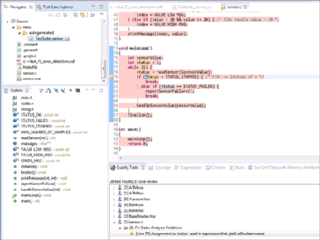Concept
The test execution engine does not carry any information about the tested product. Only the test specification and the test data carries information about the tested product.
The test specification is software. Test specification is sometimes referred to as test sequence, which consists of test steps.
The test specification should be stored in the test repository in a text format (such as source code). Test data is sometimes generated by some test data generator tool. Test data can be stored in binary or text files. Test data should also be stored in the test repository together with the test specification.
Test specification is selected, loaded and executed by the test execution engine similarly, as application software is selected, loaded and executed by operation systems. The test execution engine should not operate on the tested object directly, but through plug-in modules similarly as an application software accesses devices through drivers which are installed on the operation system.
The difference between the concept of test execution engine and operation system is that the test execution engine monitors, presents and stores the status, results, time stamp, length and other information for every Test Step of a Test Sequence, but typically an operation system does not perform such profiling of a software execution.
Reasons for using a test execution engine:
- Test results are stored and can be viewed in a uniform way, independent of the type of the test
- Easier to keep track of the changes
- Easier to reuse components developed for testing

A computer program is a sequence or set of instructions in a programming language for a computer to execute. Computer programs are one component of software, which also includes documentation and other intangible components.
Software testing is the act of examining the artifacts and the behavior of the software under test by validation and verification. Software testing can also provide an objective, independent view of the software to allow the business to appreciate and understand the risks of software implementation. Test techniques include, but are not necessarily limited to:

In computing, booting is the process of starting a computer as initiated via hardware such as a button or by a software command. After it is switched on, a computer's central processing unit (CPU) has no software in its main memory, so some process must load software into memory before it can be executed. This may be done by hardware or firmware in the CPU, or by a separate processor in the computer system.

A secure cryptoprocessor is a dedicated computer-on-a-chip or microprocessor for carrying out cryptographic operations, embedded in a packaging with multiple physical security measures, which give it a degree of tamper resistance. Unlike cryptographic processors that output decrypted data onto a bus in a secure environment, a secure cryptoprocessor does not output decrypted data or decrypted program instructions in an environment where security cannot always be maintained.

In computer science, an interpreter is a computer program that directly executes instructions written in a programming or scripting language, without requiring them previously to have been compiled into a machine language program. An interpreter generally uses one of the following strategies for program execution:
- Parse the source code and perform its behavior directly;
- Translate source code into some efficient intermediate representation or object code and immediately execute that;
- Explicitly execute stored precompiled bytecode made by a compiler and matched with the interpreter Virtual Machine.

In computer science, a library is a collection of non-volatile resources used by computer programs, often for software development. These may include configuration data, documentation, help data, message templates, pre-written code and subroutines, classes, values or type specifications. In IBM's OS/360 and its successors they are referred to as partitioned data sets.
The Vienna Development Method (VDM) is one of the longest-established formal methods for the development of computer-based systems. Originating in work done at the IBM Laboratory Vienna in the 1970s, it has grown to include a group of techniques and tools based on a formal specification language—the VDM Specification Language (VDM-SL). It has an extended form, VDM++, which supports the modeling of object-oriented and concurrent systems. Support for VDM includes commercial and academic tools for analyzing models, including support for testing and proving properties of models and generating program code from validated VDM models. There is a history of industrial usage of VDM and its tools and a growing body of research in the formalism has led to notable contributions to the engineering of critical systems, compilers, concurrent systems and in logic for computer science.
Btrieve is a transactional database software product. It is based on Indexed Sequential Access Method (ISAM), which is a way of storing data for fast retrieval. There have been several versions of the product for DOS, Linux, older versions of Microsoft Windows, 32-bit IBM OS/2 and for Novell NetWare.
In software testing, test automation is the use of software separate from the software being tested to control the execution of tests and the comparison of actual outcomes with predicted outcomes. Test automation can automate some repetitive but necessary tasks in a formalized testing process already in place, or perform additional testing that would be difficult to do manually. Test automation is critical for continuous delivery and continuous testing.

MonetDB is an open-source column-oriented relational database management system (RDBMS) originally developed at the Centrum Wiskunde & Informatica (CWI) in the Netherlands. It is designed to provide high performance on complex queries against large databases, such as combining tables with hundreds of columns and millions of rows. MonetDB has been applied in high-performance applications for online analytical processing, data mining, geographic information system (GIS), Resource Description Framework (RDF), text retrieval and sequence alignment processing.
Intel Trusted Execution Technology is a computer hardware technology of which the primary goals are:
Gadfly is a relational database management system written in Python. Gadfly is a collection of Python modules that provides relational database functionality entirely implemented in Python. It supports a subset of the standard RDBMS Structured Query Language (SQL).

The Apollo Abort Guidance System was a backup computer system providing an abort capability in the event of failure of the Lunar Module's primary guidance system during descent, ascent or rendezvous. As an abort system, it did not support guidance for a lunar landing.
Microsoft SQL Server is a proprietary relational database management system developed by Microsoft. As a database server, it is a software product with the primary function of storing and retrieving data as requested by other software applications—which may run either on the same computer or on another computer across a network. Microsoft markets at least a dozen different editions of Microsoft SQL Server, aimed at different audiences and for workloads ranging from small single-machine applications to large Internet-facing applications with many concurrent users.
Effi is C++ application development framework.

Apache Hive is a data warehouse software project built on top of Apache Hadoop for providing data query and analysis. Hive gives an SQL-like interface to query data stored in various databases and file systems that integrate with Hadoop. Traditional SQL queries must be implemented in the MapReduce Java API to execute SQL applications and queries over distributed data. Hive provides the necessary SQL abstraction to integrate SQL-like queries (HiveQL) into the underlying Java without the need to implement queries in the low-level Java API. Since most data warehousing applications work with SQL-based querying languages, Hive aids portability of SQL-based applications to Hadoop. While initially developed by Facebook, Apache Hive is used and developed by other companies such as Netflix and the Financial Industry Regulatory Authority (FINRA). Amazon maintains a software fork of Apache Hive included in Amazon Elastic MapReduce on Amazon Web Services.
The following outline is provided as an overview of and topical guide to the Perl programming language:

Parasoft C/C++test is an integrated set of tools for testing C and C++ source code that software developers use to analyze, test, find defects, and measure the quality and security of their applications. It supports software development practices that are part of development testing, including static code analysis, dynamic code analysis, unit test case generation and execution, code coverage analysis, regression testing, runtime error detection, requirements traceability, and code review. It's a commercial tool that supports operation on Linux, Windows, and Solaris platforms as well as support for on-target embedded testing and cross compilers.
This article discusses a set of tactics useful in software testing. It is intended as a comprehensive list of tactical approaches to Software Quality Assurance (more widely colloquially known as Quality Assurance and general application of the test method.
This glossary of computer science is a list of definitions of terms and concepts used in computer science, its sub-disciplines, and related fields, including terms relevant to software, data science, and computer programming.








